Fixing Sony's Grip
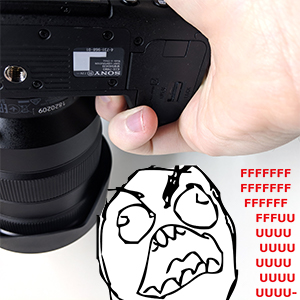
Years ago, when I decided to sell all of my Canon gear and switch to a mirrorless Sony system (the NEX-7, at the time), I was running away from giant, heavy equipment that actually made me less likely to take my camera with me, just because of the inconvenience of it.
I loved, loved, shooting the NEX-7. So small and light, and yet it took amazing pictures, and there were (and still are) tons of lenses for the mount, from all different makers.
But once I got a couple bigger lenses, and then ultimately moved to the a7II, that tiny grip just would not do.
To the right, observe an artist’s rendition of my emotions while using the grip on my a7RIII, where you can see that my entire pinky finger has nowhere to go. Nowhere but into a little cramped ball during a day of shooting.
I don’t fault Sony for this at all; if you want a smaller camera, that’s what you’re going to get, but I had to do something, and do something I did.
Read on to learn about my voyage through the world of “quick release plates” and “L brackets” and why you should absolutely be using an “L” bracket on your camera.
Big Huge Hands Problems
I’ve got some pretty big hands, and these paws just don’t fit on the modest grips of most mirrorless cameras today. But even if you have normal-sized hands, I’m betting that you could benefit from an “L” bracket.
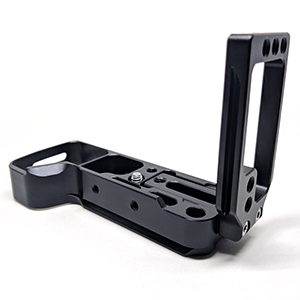
Chances are, if you have a tripod with a quick release, you already have a quick release plate (or have had one before). Quick release plates are great, and I’ve owned many myself, but a regular quick release plate won’t let you mount your camera vertically, so you’ll have to rely on your tripod head to be able to turn sideways and I’ve always found that awkward.
What you really need is an “L” bracket, like the one shown above (which happens to be my current one). Because it has Arca-Swiss-style quick release notches on both the bottom and the side, you can quickly mount your camera on the tripod horizontally or vertically.
It also adds about a half inch of grip height, which is… Well, amazing.
All About “L” Brackets
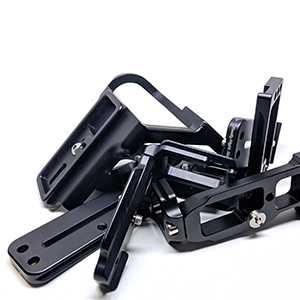
Not all of these “L” brackets (or quick release plates) are created equal. The biggest differences that I’ve seen among them lie in the design, in the shape of the bracket itself. Take my word for it, I’ve owned a lot of these; pictured to the right are all of the brackets and plates that I still have and could find for the photo.
Camera manufacturers don’t always sell these kinds of brackets themselves, although tripod mount makers, like Really Right Stuff, almost always do. I use a Really Right Stuff ball head, which I absolutely love, but for me their brackets and plates are just far too expensive.
For example, for my Sony Alpha a7RIII, the Really Right Stuff “L” bracket is $200. For a piece of milled aluminum. By contrast, there are totally serviceable Asian-made alternatives on Amazon, made for my specific camera, for as little as $27 and as much as $60.
I’ll tell you what, for $140 less, I can accept a couple minor design flaws. And that’s what I did.
What to Look Out For
So you want to pick up an “L” bracket. Here are some things to keep in mind.
Some brackets have a “telescoping” vertical mount, which means that the side piece that you mount on your tripod when you want a vertical orientation can be loosened (usually with a hex screw) and slid in and out from the main bracket base.
You really want this telescoping feature, especially with the Sony Alpha cameras, because that left side of the camera has all of the accessory ports on it. Getting access to those port covers when the side of the bracket is up against the camera is super annoying, so you’ll want to be able to space it out a bit, to your liking.
Second, if you want a bracket that extends the grip, which was one of the main reasons I wanted one, keep in mind that the battery is in there, and you need to be able to access it easily. My bracket just has a hollow space there, like this:
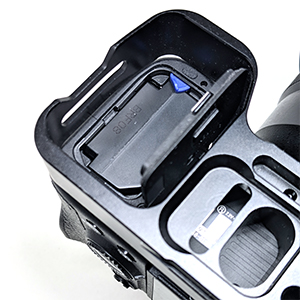
I don’t have any problems with this because my hands are big but my fingers are long so I can easily operate the battery cover and the retaining clip inside, but your mileage may vary.
Some brackets allow you to remove the battery door from the camera and mount it onto the bracket itself. I think that’s really clever, but I haven’t used one of these myself.
Ergonomics
The last thing I want to talk about is how it feels to use one of these things. The one I currently have is by far the “tallest” bracket that I’ve ever seen, but it does allow my entire pinky finger to rest below the camera’s normal grip, which is extremely pleasant for me.
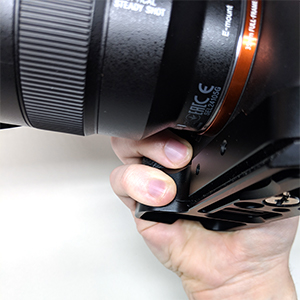
Don’t get me wrong, the a7RIII is not a light camera, but adding this mostly-hollow aluminum bracket adds so much ergonomic benefit with so little weight gain, that I think it’s a no-brainer even if your camera is a very lightweight model like the a6000 or similar.
Conclusion
If you take nothing else away from this story, let it be that it is possible to enjoy the benefits of a compact and lightweight mirrorless camera body and also get an ergonomic grip experience similar to that of a full-size DSLR.
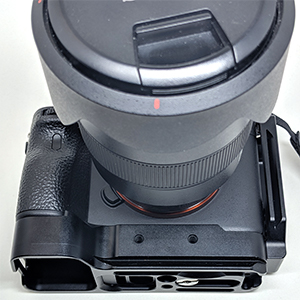
Now, when I get a new camera body, one of the first things I do is browse B&H and Amazon looking for a nice add-on “L” bracket that will allow me to quickly and easily mount the camera to my tripods in both horizontal and vertical orientations and hold the thing comfortably for a long time without my hand cramping up.
Do you use a bracket like this on your mirrorless camera? Do you think I’m silly for not just adding a battery grip? Tell me in the comments below!
 Single-Serving Photo
Single-Serving Photo
Comments